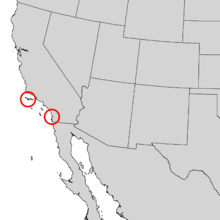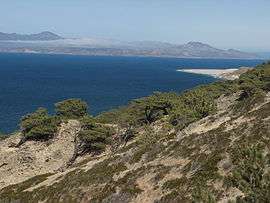Torrey pine
The Torrey pine, Pinus torreyana, is a rare pine species in the United States. It is an endangered species growing only in the Torrey Pines State Natural Reserve, coastal northern San Diego county, and on Santa Rosa Island.[2] This species is endemic to the coastal sage and chaparral ecoregion in the U.S. state of California.[3][4]
| Pinus torreyana Torrey pine[1] | |
|---|---|
 | |
| A Torrey pine on the northeast coast of Santa Rosa Island, California | |
| Scientific classification | |
| Kingdom: | Plantae |
| Clade: | Tracheophytes |
| Division: | Pinophyta |
| Class: | Pinopsida |
| Order: | Pinales |
| Family: | Pinaceae |
| Genus: | Pinus |
| Subgenus: | P. subg. Pinus |
| Section: | P. sect. Trifoliae |
| Subsection: | P. subsect. Ponderosae |
| Species: | P. torreyana |
| Binomial name | |
| Pinus torreyana Parry ex Carr. | |
 | |
| Natural range of Pinus torreyana | |
Description
Pinus torreyana is a broad, open-crowned pine tree growing to 8–17 meters (26–56 ft) tall in the wild, with 25–30 centimeters (9.8–11.8 in) long leaves ('needles') in groups of five. The cones are stout and heavy, typically 8–15 cm (3.1–5.9 in) long and broad, and contain large, hard-shelled, but edible, pine nuts.[3] The species name torreyana is named for John Torrey, an American botanist, after whom the coniferous genus Torreya is also named.[5]
Distribution
The "wild" native population of Pinus torreyana is restricted to trees growing in a narrow strip along the Southern California coast in San Diego.[6] There is also a population of the variety Pinus torreyana var. insularis in two groves on Santa Rosa Island, a California Channel Island off the coast of Santa Barbara.[7][8] The presence of Torrey pines along the semi-arid coast of San Diego and Santa Rosa Island (rainfall less than 15 inches per year) is probably a relic population of a much more extensive Ice Age distribution. Coastal fog during spring and summer along the San Diego and Santa Rosa Island coast provides just enough moisture to supplement the fairly low winter rainfall, allowing for survival of the species in the wild habitat zone.[9]
Habitat
In its native habitat, Pinus torreyana is found in the coastal sage scrub plant community, growing slowly in dry sandy soil. The root system is extensive. A tiny seedling may quickly send a taproot down 60 centimeters (24 in) seeking moisture and nutrients. A mature tree may have roots extending 75 meters (246 ft). Exposed trees battered by coastal winds are often twisted into beautiful sculptural shapes resembling large bonsai, and rarely exceed 12 m (39 ft) tall.
Conservation
Pinus torreyana was one of the rarest pine species in the world in the early 20th century, with only around 100 trees surviving. Pinus squamata, a critically endangered species in southwest China, is considered the rarest pine currently with only around 20 trees remaining.
Uses
Food
The pine nuts were an important food for the Kumeyaay tribe and the Chumash tribe of Native American people.[10] They are also eaten by birds and rodents.[11]
Cultivation
Endangered in the wild, Torrey pine is planted as an ornamental tree.[12] They are used in native plant and drought tolerant gardens and landscapes. Under cultivation, on richer soils with higher rainfall or supplemental irrigation, the Torrey pine is capable of fast growth to a large size, with tall and straight trees from 33 meters (108 ft)[12] to 45 m (148 ft) in height.[13][14]
The Torrey pine is protected by a city tree ordinance in Del Mar, near the native habitat, and construction projects and citizens require a permit for its removal.[15]
Forestry
Pinus torreyana has been considered as a plantation tree for forestry use in Australia, New Zealand and Kenya.[16]
Naming
In San Diego County it is considered a local icon, where it lends its name to Torrey Pines State Reserve, Torrey Pines State Beach, Torrey Pines Golf Course, Torrey Pines High School, and Torrey Pines Gliderport, as well as numerous local roads and businesses (e.g., Torrey Pines Bank,[17] Torrey Pines Property Management Company,[18] Torrey Pines Landscape Company, and[19] Torrey Pines Law Group[20]), and parks.
Terminology
Some unusual terms that are used to describe the Torrey pine are:
- fascicle (botany) – a cluster of needles, which consists of a fixed number of needles for each pine species, which is five for the Torrey pine[21][22]
- stratification (botany) – the process of subjecting seeds to cold in order to encourage germination, which is a recommended practice for Torrey pine seeds[23][24]
- strobilus (plural: strobili) – a structure that functions as a flower but looks like a small cone, which for the Torrey pine looks like a yellow bud in a male strobilus and looks like a small red cone in a female strobilus[25][26]
- witch's broom – an unusually dense cluster of needles, which looks somewhat like a bird's nest, which can be caused by disease or some other cause,[27][28] also called "gorilla's nest"[29]
Gallery
 Torrey pine: female pine cones
Torrey pine: female pine cones A wild Torrey pine grove, Santa Rosa Island, California.
A wild Torrey pine grove, Santa Rosa Island, California. Strobili on a Torrey pine
Strobili on a Torrey pine Torrey Pine Mature Bark and Nameplate in Mildred E. Mathias Botanical Garden, Los Angeles, California
Torrey Pine Mature Bark and Nameplate in Mildred E. Mathias Botanical Garden, Los Angeles, California
References
- Conifer Specialist Group (1998). "Pinus torreyana var. torreyana". IUCN Red List of Threatened Species. 1998. Retrieved May 11, 2006.CS1 maint: ref=harv (link) Listed as Endangered (EN C2b)
- "Santa Rosa Island". Channel Islands. National Park Service. Retrieved January 30, 2018.
- "Pinus torreyana Parry ex Carrière". Ucjeps.berkeley.edu. Retrieved August 9, 2013.
- C. Michael Hogan (September 11, 2008). "Torrey Pine (Pinus torreyana)". GlobalTwitcher.com. Archived from the original on May 25, 2012. Retrieved August 9, 2013.
- Lisa (September 22, 2010). "Tree Identification: Pinus torreyana - Torrey Pine". Lh2treeid.blogspot.com. Retrieved August 9, 2013.
- Moore, Gerry; Kershner, Bruce; Craig Tufts; Daniel Mathews; Gil Nelson; Spellenberg, Richard; Thieret, John W.; Terry Purinton; Block, Andrew (2008). National Wildlife Federation Field Guide to Trees of North America. New York: Sterling. p. 84. ISBN 978-1-4027-3875-3.
- "Pinus torreyana Parry ex Carrière subsp. insularis J. R. Haller". Ucjeps.berkeley.edu. Retrieved August 9, 2013.
- Earle, Christopher J., ed. (2018). "Pinus torreyana". The Gymnosperm Database. Retrieved May 4, 2014.
- Williams, A. Park; Still, Christopher J.; Fischer, Douglas T.; Leavitt, Steven W. (2008). "The influence of summertime fog and overcast clouds on the growth of a coastal Californian pine: A tree-ring study". Oecologia. 156 (3): 601–611. doi:10.1007/s00442-008-1025-y.
- "Torrey Pine". Nature Collective. Retrieved April 22, 2020.
- Peattie, Donald Culross (1953). A Natural History of Western Trees. New York: Bonanza Books. pp. 96–97.
- Anne Krueger (February 6, 2007). "Residents say tree too big, too old for neighborhood". Union-Tribune Publishing Co. Archived from the original on January 31, 2017. Retrieved January 31, 2016.
Houses replaced avocado groves on the East County land that surrounds the Torrey pine. The tree, now 60 or 70 years old, towers 108 feet over Queen Avenue.
...
Torrey pines are widely planted as an ornamental species, and can grow in temperate climates around the world. - "TORREY PINE HABITAT". Shipley Nature Center. Retrieved May 31, 2014.
In cultivation, it is capable of growth up to 148 feet
- "Torrey Pine, Pinus torreyana". redOrbit. Conifers Reference Library. Retrieved May 31, 2014.
The Torrey pine is planted as ornamental trees, with better soil and with controlled watering, it lends to being a fast growing tree to heights of 148 feet. This pine is drought tolerant as the tap roots can go as deep as 200 feet to find moisture. The tree is also shade tolerant.
- "How can I cut my tree down?". City of Del Mar. Retrieved May 11, 2014.
- McMaster, Gregory Scott (1980). Patterns of reproduction in Torrey pine (Pinus torreyana) (Thesis). San Diego, California: San Diego State University.
- "Torrey Pines Bank". December 17, 2010. Retrieved August 6, 2013.
- "Torrey Pines Property Management Company, San Diego Property Management, Apartments for Rent in San Diego, CA". Retrieved August 6, 2013.
- "San Diego Landscape Designers Contractors Torrey Pines Landscaping". Tplandscape.com. Retrieved August 6, 2013.
- "Torrey Pines Law Group". June 1, 2020. Retrieved June 1, 2020.
- Earle, Christopher J., ed. (2018). "Pinus torreyana". The Gymnosperm Database. Retrieved August 6, 2013.
- "Chaparral and Riparian Plants". Sci.sdsu.edu. Retrieved August 6, 2013.
- Esser, Lora L. (1993). "Pinus torreyana". Fire Effects Information System (FEIS). US Department of Agriculture (USDA), Forest Service (USFS), Rocky Mountain Research Station, Fire Sciences Laboratory. Retrieved August 6, 2013 – via https://www.feis-crs.org/feis/.
- Santiago (January 25, 2005). "germination of Torrey pines". Archived from the original on April 25, 2012. Retrieved August 9, 2013.
- "Natural Treasure: The One and Only Torrey Pine". Naturaltreasureucsd.blogspot.com. February 7, 2011. Retrieved August 6, 2013.
- "Life Cycle - torreypinedo2". Sites.google.com. July 22, 2011. Retrieved August 6, 2013.
- "Welcome to My Garden!: Torrey Pines State Reserve". Loresgardens.blogspot.com. August 17, 2008. Retrieved August 6, 2013.
- "Torrey Pine". Project Noah. Retrieved August 6, 2013.
- jiobrien. "Torrey Pine with witch's broom". Archived from the original on April 5, 2012. Retrieved May 4, 2014.
The witch's broom or gorrila's nest is an abnormal area of growth on the tree of uncertain origin.
External links
| Wikimedia Commons has media related to Pinus torreyana. |
